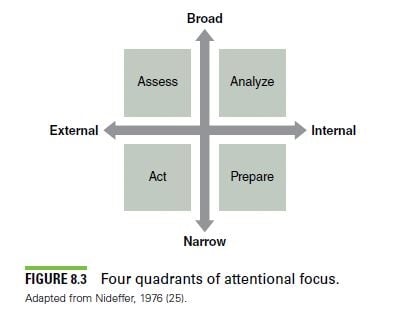Attentional Styles
by Essentials of Strength Training and Conditioning-4th Edition With Web Resource
Kinetic Select
June 2017
Understanding attentional styles can improve coaching effectiveness by allowing the coach to provide appropriate cues or methods for each athlete.
The following is an exclusive excerpt from the book Essentials of Strength Training and Conditioning-4th Edition With Web Resource, published by Human Kinetics. All text and images provided by Human Kinetics.
Nideffer (25) formulated an important concept in sport psychology when he theorized that individuals tend to experience shifting categories of attentional styles during performance. These categories are characterized by two dimensions: direction (internal-external) and width (broad-narrow). The first dimension refers to an introspective versus an externally oriented perspective, whereas the second dimension refers to an integrative (expansive) versus a highly selective orientation. These dimensions each occur on overlapping continuums, creating four “quadrants” of attentional focus: (1) broad external, in which the athlete assesses the situation by looking at the environment and various elements within it; (2) broad internal, in which the athlete processes information and develops a strategy; (3) narrow internal, in which the athlete mentally rehearses the upcoming action; and (4) narrow external, in which the athlete specifically focuses on one or two external cues to generate action. These constructs and their relationships to each other can be seen in figure 8.3.
Figure 8.3: Four quadrants of attentional focus

Understanding attentional styles can improve coaching effectiveness. For example, a player who tends to become overloaded with external stimuli might be coached to focus on one important cue, such as an opponent’s footwork. Athletes who seem to get lost in their own head could practice describing out loud, to a coach, what they are feeling during a lunge. Without such coaching, these players would likely attend to inappropriate cues and react too slowly.
Developed by the National Strength and Conditioning Association, Essentials of Strength Training and Conditioning, Fourth Edition, is the fundamental preparation text for the CSCS exam as well as a definitive reference that strength and conditioning professionals will consult in everyday practice. The book is available in bookstores everywhere, as well online at the NSCA Store.
- Privacy Policy
- Your Privacy Choices
- Terms of Use
- Retraction and Correction Policy
- © 2025 National Strength and Conditioning Association